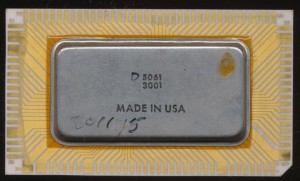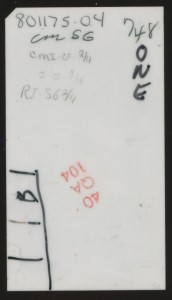The Forgotten Ones: HP D5061-30xx Processors
40+ Years after computer processors began to be made, there are several that stick in peoples minds as ‘the greats’ as being somehow more important then others. Processors such as the Intel 4004, the MOS 6502 of Apple fame, and the Motorola 6800 have taken histories podium as the most important.
The truth, however, is a bit different, yet no less exciting. There are those processors that at their time, were vastly ahead of their time, such technological marvels that they continued to be competitive for a decade, impressive today, nearly unheard of in the 1970’s. Some of these processors never saw wide use in PCs, such as the 1802 or SMS300 yet were remarkable. Still others were designed not to be mass market, or to be licensed but to satisfy a company’s internal needs for a processor to power their equipment. These in house designs were every bit as impressive as the competition but since they were used by their creators alone, they faded into obscurity. One such example was the Bell Labs BELLMAC-8, designed by, and for Western Electric. They were not alone however…
When one thinks of Hewlett-Packard one typically thinks of PC’s, Printers, or perhaps, very well built test and measurement gear. In the 1970’s HP made some of the best test/measurement systems available. They also made a line of desktop calculators, that rather blurred the line between computer and calculator. It was for these, specifically the HP 9825 desktop computer that HP began one of their first processor designs. The year? 1973. Intel was making the 4004 on a 10 micron PMOS process running at a 740KHz. It ran calculators and a host of other equipment. It was a 4-bit process, soon to be replaced by the 8-bit 8008. Intel’s first 16-bit design would be the 80286, in the early 1980’s.
HP had looked at process technology and in the early 1970’s select NMOS over PMOS. NMOS had greater potential, albeit trickier to make at the time. In 1973 HP began using their second generation NMOS process, a shrink to 5 microns from the original 7 microns. Even at 5 microns the 16-bit design of the 5061-30xx took multiple dies, all bonded on one package, to implement. The final result was a single ceramic package containing 3 dies: a BPC (Binary Processor Chip) that executed 57 instructions, an EMC Extended Math Chip, which handled 15 floating point type math instructions, and the IOC, an I/O chip which implemented 12 I/O instructions. A later version (the D5061-3001) would add a 4th chip to the package called the AEC, Address Extension chip, allowing this 1970’s design to address up to 4GB of memory.
The 5061-30xx ran at up to 10MHz, and dissipated 6 Watts, necessitating the use of a heatsink in most applications. All three die contained approx. 18,000 transistors, the AEC added another roughly 6,000. By comparison, the 4004 has 2300. In all HP made at least 7 different versions of the processor:
- 09825-67907 – Original Version Used in the HP 9825- 82 contact package
- 1813-0065 – Used in the 9825A (1978-1979, Board 09825-66511 Rev D) – 82 contact package
- 5061-3010 – Revised with increased Address Space – Used in the 9845 – 82 contact package
- 5061-3011 – Does not include the EMC math chip – Also used in the 9845 and Hp 64110A (64110-66530)- 82 contact package
- 5061-3012 – 56 pin version used as a tape controller – made on an NMOS III Process – 4MHz clock
- 5061-3020 – 4×20 bit hybrid shift register, used as a line buffer in HP thermal printers
- 5061-3043 – Variant of the -3010 used in the HP 250 – 82 contact package
- 5061-4204 – 3010 version used in the 8566A/8568A Spectrum Analysers – 82 contact package
- 5061-3001 – Added the AEC Extended Address Chip – 107 contact package
- 1818-2500 – 40 pin version including only the BPC – Used for peripheral control
These processors continued to be made until the mid 1980’s when other processors performance caught up enough to make replacing them viable and economical.
While not widely known, the HP processors are fairly well documented. (with the exception of any kind of datasheet it seems)
Additional information may be found here:
HP9825.COM The Story of the Little Computer That Could
The Vintage Technology Association
The HP 9845 Project




April 1st, 2014 at 1:11 pm
[…] με κεντρικό επεξεργαστή. Και πιο συγκεκριμένα τον HP 5061, μία υβριδική μορφή bit slice 16μπιτου επεξεργαστή. Δηλαδή […]
April 7th, 2014 at 12:17 am
[…] The Forgotten Ones: HP D5061-30xx Processors […]
March 27th, 2015 at 4:28 pm
Hello from Germany,
I’ m CPU-Collector. My question(s):
How rare is that CPU ?
And how much is this CPU (Including the Co-CPU) ?
Thanxs for an answer:-)
March 28th, 2015 at 1:57 am
These are fairly rare, the equipment they were in was not widely produced, and of course fairly old. The non-AEC versions tend to be $50-$60
THe versions with the AEC are more.
March 14th, 2016 at 10:29 am
Hp D5061-3001 + 3 pcb(hp)> hp retro digital multimeter (1976 -1988)
September 2nd, 2020 at 11:33 pm
Hi admin,
Change “too multiple die’s,” to “took multiple dies,”, “a BPC” to “A BPC” for slightly better English.
Cheers, Brian.